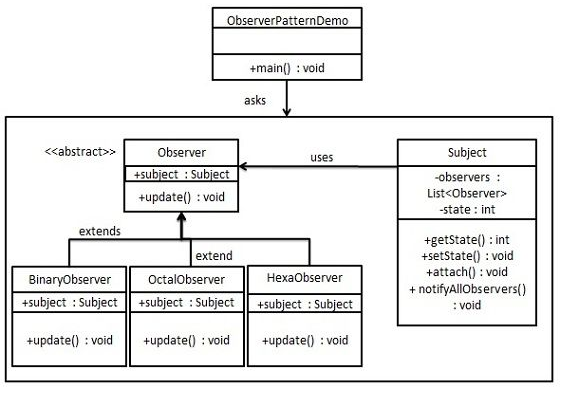观察者模式属于一种行为型模式。
观察者模式定义了一种对象间的一对多的依赖关系。当一个对象的状态发生改变时,所有依赖于它的对象都会得到通知并自动更新。
菜鸟教程中的这幅图比较直观(说白了就是,目标对象中维护着一个list存放所有的观察者对象,所有的观察者对象实现同一个observer接口来实现解耦)

下面举一个常见的气象站的例子,就是不同的人(学生,工人)收到天气预报的改变后作出相应的处理
气象站对象(这个就相当于上图中的Subject,也就是目标对象)
public class WeatherStation { String[] weathers = {"天晴", "下雨", "台风"}; ArrayList<Person> list = new ArrayList<>(); public void addPerson(Person person) { list.add(person); } public void updateWeather() throws InterruptedException { while(true) { Random random = new Random(); String weather = weathers[random.nextInt(weathers.length)]; System.out.println(weather); for(Person person: list) { person.doSomething(weather); } long time = random.nextInt(501)+1000; Thread.sleep(time); } } }
观察接口(也就是上图中的observer接口)
public interface Person { void doSomething(String weather); }
学生对象
public class Student implements Person{ String name; public Student(String name) { this.name = name; } @Override public void doSomething(String weather) { if("天晴".equals(weather)) { System.out.println(name + "该去上学!"); }else if("下雨".equals(weather)) { System.out.println(name + "撑伞去上学!"); }else if("台风".equals(weather)) { System.out.println(name + "不用上学!"); } } }
工人对象
public class Worker implements Person{ String name; public Worker(String name) { this.name = name; } @Override public void doSomething(String weather) { if("天晴".equals(weather)) { System.out.println(name + "该去上班!"); }else if("下雨".equals(weather)) { System.out.println(name + "撑伞去上班!"); }else if("台风".equals(weather)) { System.out.println(name + "不用上班!"); } } }